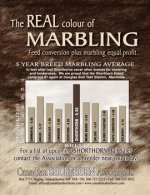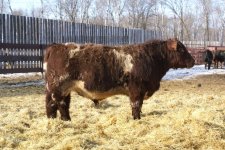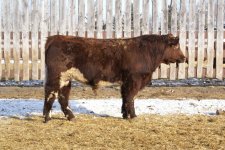I see no reason to push a set of bulls to see how much they can gain in a 112 day period. Why risk the possibility of messing up the longevity of a herd sire? I know there have been some pretty powerful bulls come out of the Douglas Bull test, but I also know of many that have been ruined by the test. I have gone there many times, over the years, and I have gone there on three specific times to purchase a herd sire. Two of these times, the bulls I was interested were foundered to a point where they could hardly walk and I would not risk buying them. I did buy one bull out of this test that turned out to be a good breeding bull, however at 3 years of age his feet were growing like a weed sprayed with 2-4 D. Whether it was the feed he received or his genetics I don't know, but I 'm betting on the feed that was a cause of this. I also disagree with the policy of not allowing bulls that reach a certain index to sell. I remember one year that several of the very best bulls did not make the sale, simply because they came into the test with high weaning weights and they did not gain as fast during the test period. Several of these bulls were 250 lbs heavier than some of the bulls in the sale,. but they could not sell. This is why we do not cull our bulls for ADG or WPDA, because we would end up removing almost every low BW bull and those bulls suitable to use on heifers. We allow the buyers to decide what they want for their program and so far it seems to have been working well.
When we started our bull test, I was very happy when every consignor was in favor of feeding a high roughage ration designed for optimum growth and not maximum growth. This ration allows the bulls to express their growth without burning their guts and joints. I think it has proven to be a very good policy and I am very pleased with how atheltic these bulls are. We have several customers who have told us that our bulls are too good to sell for meat when they are done using them... which I think is a great compliment.
Rate of gain contests should be only for steers that will be slaughtered at the end of test. I do not feel these tests should ever be used for breeding animals .. of either sex. Breeding stock should be developed to stand the test of time, not just the test of a few short months.



